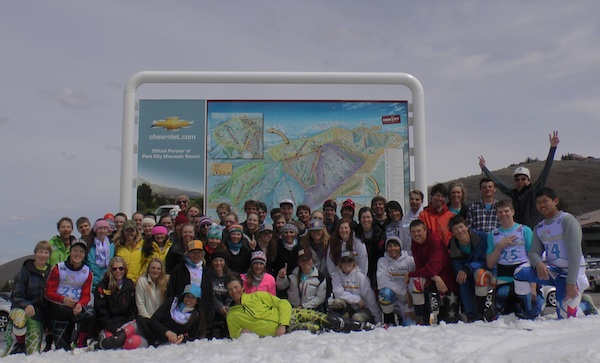Alpine U16 National Championships Recap

The 2013 U16 National Championships featured racing, testing and education for the top ten alpine boys and girls from each region. Understanding that at this age and developmental phase there are still many aspects that are developing that will be factors in the athlete's long-term potential, the event went beyond just race results in determining a champion. Overall results were based on their performance in GS, slalom, parallel, SkillsQuest, and a technical freeski assessment. In addition, the athletes underwent physical testing and a medical screening, learned about mental strength training from one of USSA's sport psychology consultants and had a chance to talk with U.S. Ski Team coaches. Said USSA Alpine Director Patrick Riml, "I think it's the greatest event to see all these kids performing on different paths, freeskiing, SkillsQuest, and slalom and GS. It's not a training camp. It's a competition. So it's a test."
A test it was. It was not an easy week. Weather and snow conditions were extremely challenging, as over a foot of snow fell on the first day making for challenging conditions for the freeskiing assessment and the races. The races were held on the Olympic GS trail at Park City, a hill with extremely steep sections made more challenging by deteriorating snow. The message to the racers and coaches – don't expect conditions to always be perfect, be adaptable. Watching video of the top finishers, you'll see big mistakes and good recoveries. To win it took a high degree of skill and a lot of resilience.
"We have some really good skiers here," said Lester Keller, USSA Regional Development Director. "But we see some things that we're deficient as a nation in. These kids are in pretty good physical condition, but not good enough. So we definitely need to get the message out to the nation that we need to do a lot more work in fitness. We're working on a total athletic model, taking in different dimensions of athletic performance that are specific to alpine skiing like technique, tactics, physical fitness and conditioning, mental skills and mental strength, nutrition, and all of those things that go into it. We're just trying to ramp up the expectation so that people understand what it takes to be a world-class athlete."
Skiing events (all held at Park City Mountain Resort)
Technical freeskiing assessment
Four challenging freeskiing assessments judged by a panel of U.S. Ski Team coaches and USSA High Performance staff on a scale of 0-10. All exercises performed on GS skis. Top finisher based on average score of the four assessments below.
- Medium/long radius turns in moguls: Tested skiers ability to maintain balance, ski/snow contact, timing and rhythm while skiing GS radius turns on a steep mogul trail (Thaynes trail).
- Freeski hourglass in ungroomed terrain: Tested skiers ability to continually change turn radius while maintaining balance, rhythm and flow in rough, uneven terrain (Double Jack trail). Same protocol as for SkillsQuest freeskiing assessment for phase 4, but on steep, expert, ungroomed terrain.
- Short-swing turns: Tested the skiers ability to maintain consistent rhythm while performing a series of short swing turns in a defined corridor on a steep slope in ungroomed terrain over a long distance (Prospector trail).
- GS-SL-GS change-up: Tested the skiers ability to manage the transition from GS turns directly into slalom turns, then directly back into GS turns again while maintaining control and not stalling their movements (Dynamite trail). Ungroomed, expert trail.
SkillsQuest skiing assessment
Testing took place in the afternoon of the technical freeskiing assessment day and following the GS race. Athletes were required to use GS skis for the assessment to increase the challenge and show their versatility. Four exercises were assessed: pole jumpers in a tuck, one ski skiing with lane changes, sideslip to straight run to sideslip, and hop turns. See the girls results and boys results in the SkillsQuest assessments.
GS race
Standard two-run scored race seeded by USSA points. Held on C.B.'s run, the Olympic GS trail. Difficult conditions due to heavy new snow over old spring snow. Technically demanding course sets by U.S. Ski Team coaches at 25-27m distances.
Slalom race
Standard two-run scored race seeded by USSA points. On GS hill, with start at top of steep 2nd pitch. Difficult conditions due to variable snow surface. Technically demanding course sets by U.S. Ski Team coaches at generally 9-10.5m distances.
Parallel race
Single qualifying run to determine seeding. Brackets of 32. Held on lower Picabo's trail. Course set at 18-20m distances. Weather light to moderate rain, rough snow. Each athlete runs red and blue course head-to-head, with differential timing. The parallel has in both years brought out a different level of racing. Racers learn a lot about their limits and tend to race more instinctually. At this type of event, parallel racing is fun, exciting and emphasizes versatility, resilience and competitiveness.
Final results
40% based on skiing assessments, 60% based on racing, with the technical freeski assessment, SkillsQuest, GS, slalom and parallel each counting for one-fifth of the total score. Athletes ranked in each event and awarded World Cup points based on rank. In order to win the U16 National Championships, skiers must have both a high degree of speed and broad skiing skills. The USSA believes that these factors together give a better overall sense of a ski racer's future potential than just speed or skills alone. See the overall results below.
View video from the top finishers at the event here.
